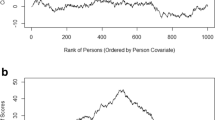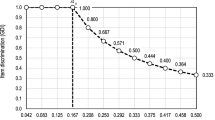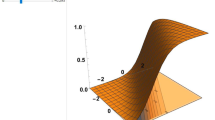Abstract
The paper addresses three neglected questions from IRT. In section 1, the properties of the “measurement” of ability or trait parameters and item difficulty parameters in the Rasch model are discussed. It is shown that the solution to this problem is rather complex and depends both on general assumptions about properties of the item response functions and on assumptions about the available item universe. Section 2 deals with the measurement of individual change or “modifiability” based on a Rasch test. A conditional likelihood approach is presented that yields (a) an ML estimator of modifiability for given item parameters, (b) allows one to test hypotheses about change by means of a Clopper-Pearson confidence interval for the modifiability parameter, or (c) to estimate modifiability jointly with the item parameters. Uniqueness results for all three methods are also presented. In section 3, the Mantel-Haenszel method for detecting DIF is discussed under a novel perspective: What is the most general framework within which the Mantel-Haenszel method correctly detects DIF of a studied item? The answer is that this is a 2PL model where, however, all discrimination parameters are known and the studied item has the same discrimination in both populations. Since these requirements would hardly be satisfied in practical applications, the case of constant discrimination parameters, that is, the Rasch model, is the only realistic framework. A simple Pearsonx 2 test for DIF of one studied item is proposed as an alternative to the Mantel-Haenszel test; moreover, this test is generalized to the case of two items simultaneously studied for DIF.
Similar content being viewed by others
References
Aczél, J. (1966).Lectures on functional equations and their applications. New York: Academic Press.
Alper, T. M. (1987). A classification of all order-preserving homeomorphism groups of the reals that satisfy finite uniqueness.Journal of Mathematical Psychology, 31, 135–154.
Andersen, E. B. (1973). A goodness of fit test for the Rasch model.Psychometrika, 38, 123–140.
Andersen, E. B. (1985). Estimating latent correlations between repeated testings.Psychometrika, 50, 3–16.
Baker, F. B. (1992).Item response theory. New York: Marcel Dekker.
Bereiter, C. (1963). Some persisting dilemmas in the measurement of change. In C. W. Harris (Ed.),Problems in measuring change (pp. 3–20). Madison: The University of Wisconsin Press.
Birnbaum, A. (1968). Some latent trait models and their use in inferring an examinee's ability. In F. M. Lord & M. R. Novick (Eds.),Statistical theories of mental test scores (pp. 395–479). Reading, MA: Addison-Wesley.
Churchhouse, R. F. (1981).Handbook of applicable mathmatics, Vol. III. Chichester and New York: J. Wiley.
Colonius, H. (1979). Zur Eindeutigkeit der Parameter im Rasch-Modell [On the uniqueness of parameters in the Rasch model].Psychologische Beiträge, 21, 414–416.
Cronbach, L. J., & Furby, L. (1970). How should we measure change—or should we?Psychological Bulletin, 74, 68–80.
Embretson, S. E. (1991). A multidimensional latent trait model for measuring learning and change.Psychometrika, 56, 495–515.
Fischer, G. H. (1972). A measurement model for the effect of mass-media.Acta Psychologica, 36, 207–220.
Fischer, G. H. (1974).Einführung in die Theorie psychologischer Tests [Introduction to mental test theory. In German]. Berne: Huber.
Fischer, G. H. (1976). Some probabilistic models for measuring change. In D. N. M. de Gruijter & L. J. Th. van der Kamp (Eds.),Advances in psychological and educational measurement (pp. 97–110). New York: J. Wiley.
Fischer, G. H. (1981). On the existence and uniqueness of maximum-likelihood estimates in the Rasch model.Psychometrika, 46, 59–77.
Fischer, G. H. (1983). Logistic latent trait models with linear constraints.Psychometrika, 48, 3–26.
Fischer, G. H. (1987). Applying the principles of specific objectivity and generalizability to the measurement of change.Psychometrika, 52, 565–587.
Fischer, G. H. (1988). Spezifische Objektivität: Eine wissenschaftstheoretische Grundlage des Rasch-Modells [Specific objectivity: A theoretical foundation of the Rasch model. In German]. In K. D. Kubinger (Ed.),Moderne Testtheorie (pp. 87–111). Weinhein: Beltz.
Fischer, G. H. (1989). An IRT-based model for dichotomous longitudinal data.Psychometrika, 54, 599–624.
Fischer, G. H. (1993). Notes on the Mantel-Haenszel procedure and another chi-squared test for the assessment of DIF.Methodika, 7, 88–100.
Fischer, G. H. (1995a). Derivations of the Rasch model. In G. H. Fischer & I. W. Molenaar (Eds.),Rasch models. Foundations, recent developments, and applications (pp. 15–38). New York: Springer-Verlag.
Fischer, G. H. (1995b). The linear logistic test model. In G. H. Fischer & I. W. Molenaar (Eds.),Rasch models. Foundations, recent developments, and applications (pp. 131–155). New York: Springer-Verlag.
Fischer, G. H., & Parzer, P. (1991). An extension of the rating scale model with an application to the measurement of change.Psychometrika, 56, 637–651.
Fischer, G. H., & Ponocny, I. (1994). An extension of the partial credit model with an application to the measurement of change.Psychometrika, 59, 177–192.
Glas, C. A. W., & Verhelst, N. D. (1995). Testing the Rasch model. In G. H. Fischer & I. W. Molenaar (Eds.),Rasch models. Foundations, recent developments, and applications (pp. 69–95). New York: Springer-Verlag.
Guttmann, G., & Etlinger, S. C. (1991). Susceptibility to stress and anxiety in relation to performance, emotion, and personality: The ergopsychometric approach. In C. D. Spielberger, I. G. Sarason, J. Strelau, & J. M. T. Brebner (Eds.),Stress and anxiety, Vol. 13 (pp. 23–52). New York: Hemisphere Publishing.
Hambleton, R. K. (1989). Principles and selected applications of item response theory. In R. L. Linn (Ed.),Educational measurement (pp. 147–200). New York: Macmillan, and London: Collier Macmillan.
Hamerle, A. (1979). Über die meßtheoretischen Grundlagen von Latent-Trait-Modellen [On measurement-theoretic foundations of latent trait models. In German.]Archiv für Psychologie, 132, 19–39.
Hamerle, A. (1982).Latent-Trait-Modelle. [Latent trait models]. Weinheim: Beltz. (In German)
Harris, C. W. (Ed.). (1963).Problems in measuring change. Madison: The University of Wisconsin Press.
Holland, P. W., & Thayer, D. T. (1988). Differential item functioning and the Mantel-Haenszel procedure. In H. Wainer & H. I. Braun (Eds.),Test validity. Hillsdale, NJ: Lawrence Erlbaum.
Hulin, C. L., Drasgow, F., & Parsons, C. K. (1983).Item response theory. Application to psychological measurement. Homewood, IL: Dow Jones-Irwin.
Irtel, H. (1987). On specific objectivity as a concept in measurement. In E. E. Roskam & R. Suck (Eds.),Progress in mathematical psychology (pp. 35–45). Amsterdam: North-Holland.
Irtel, H. (1994). The uniqueness structure of simple latent trait models. In G. H. Fischer & D. Laming (Eds.),Contributions to mathematical psychology, psychometrics, and methodology (pp. 265–275). New York: Springer-Verlag.
Johnson, N. L., & Kotz, S. (1969).Distributions in statistics: Discrete distributions, Vol. I. Boston: Houghton Mifflin.
Kempf, W. (1977). Dynamic models for the measurement of ‘traits’ in social behavior. In W. Kempf & B. H. Repp (Eds.),Mathematical models for social psychology (pp. 14–58). Berne: Huber.
Krantz, D. H., Luce, R. D., Suppes, P., & Tversky, A. (1971).Foundations of measurement, Vol. 1. New York/London: Academic Press.
Kubinger, K. D. (1988).Moderne Testtheorie [Modern test theory]. Weinheim: Beltz. (In German)
Lord, F. M. (1963). Elementary models for measuring change. In C. W. Harris (Ed.),Problems in measuring change (pp. 21–38). Madison: The University of Wisconsin Press.
Lord, F. M. (1980).Applications of items response theory to practical testing problems. Hillsdale, NJ: Lawrence Erlbaum.
Luce, R. D. (1990). Goals, achievements, and limitations of modern fundamental measurement theory. In H. H. Bock (Ed.),Classification and related methods of data analysis (pp. 15–22). Amsterdam: North-Holland.
McLane, S., & Birkoff, G. (1988).Algebra (3rd ed.). New York: Chelsea.
Narens, L. (1981). On the scales of measurement.Journal of Mathematical Psychology, 24, 249–275.
Pfanzagl, J. (1971).Theory of measurement. Würzburg and Vienna: Physica-Verlag.
Pfanzagl, J. (1994). On item parameter estimation in certain latent trait models. In G. H. Fischer & D. Laming (Eds.),Contributions to mathematical psychology, psychometrics, and methodology (pp. 249–263). New York: Springer-Verlag.
Rasch, G. (1960).Probabilistic models for some intelligence and attainment tests. Copenhagen: Pædagogiske Institut.
Rasch, G. (1961). On general laws and the meaning of measurement in psychology.Proceedings of the IV. Berkeley Symposium on mathematical statistics and probability, Vol. IV (pp. 321–333). Berkeley: University of California Press.
Rasch, G. (1967). An informal report on a theory of objectivity in comparisons. In L. J. Th. van der Kamp & C. A. J. Vlek (Eds.),Measurement theory (pp. 1–19). Leyden: University of Leyden. (Proceedings of the NUFFIC international summer session in science in “Het Oude Hof”, The Hague, July 14–19, 1996)
Rasch, G. (1968, September).A mathematical theory of objectivity and its consequences for model construction. Paper presented at the European Meeting on Statistics, Econometrics, and Management Science, Amsterdam, The Netherlands.
Rasch, G. (1972). Objectivitet i samfundsvidenskaberne et metodeproblem [Ojectivity in the social sciences as a methodological problem].National-økonomisk Tidsskrift, 110, 161–196. (In Danish)
Rasch, G. (1977). On specific objectivity. An attempt at formalizing the request for generaliy and validity of scientific statements. In M. Blegvad (Ed.),The Danish yearbook of philosophy (pp. 58–94). Copenhagen: Munksgaard.
Santner, T. J., & Duffy, D. E. (1989).The statistical analysis of discrete data. New York: Springer-Verlag.
Scheiblechner, H. (1995). Isotonic psychometric models (ISOP).Psychometrika, 60, 281–304.
Stene, J. (1968). Einführung in Raschs Theorie psychologischer Messung [Introduction to Rasch's theory of psychological measurement]. In G. H. Fischer (Ed.),Psychologische Testtheorie (pp. 229–268). Berne: Huber. (In German)
Steyer, R. & Eid, M. (1993).Messen und Testen [Measurement and testing]. Berlin: Springer-Verlag. (In German)
Tutz, G. (1989).Latent Trait-Modelle für ordinale Beobachtungen [Latent trait models for ordinal data]. Berlin: Springer-Verlag. (In German)
Verhelst, N. D., & Glas, C. A. W. (1993). A dynamic generalization of the Rasch model.Psychometrika, 58, 395–415.
Verhelst, N. D., & Glas, C. A. W. (1995). Dynamic generalizations of the Rasch model. In G. H. Fischer & I. W. Molenaar (Eds.),Rasch models. Foundations, recent developments, and applications (pp. 181–201). New York: Springer-Verlag.
Wainer, H., & Mislevy, R. (1990). Item response theory, item calibration and proficiency estimation. In H. Wainer (Ed.),Computerized adaptive testing: A primer. Hillsdale, NJ: Lawrence Erlbaum.
Webster, H., & Bereiter, C. (1963). The reliability of changes measured by mental test scores. In Harris, C. W. (Ed.),Problems in measuring change (pp. 39–59). Madison: The University of Wisconsin Press.
Wright, B. D., & Stone, M. H. (1972).Best test design. Chicago: Mesa Press.
Author information
Authors and Affiliations
Additional information
Presidential Address delivered at the 30th Annual Meeting of the Psychometric Society, 16–18 June 1995 in Minneapolis.
This research was supported in part by the Fonds zur Förderung der Wissenschaftlichen Forschung under Grant No. P10118-HIS.
Rights and permissions
About this article
Cite this article
Fischer, G.H. Some neglected problems in IRT. Psychometrika 60, 459–487 (1995). https://doi.org/10.1007/BF02294324
Issue Date:
DOI: https://doi.org/10.1007/BF02294324




